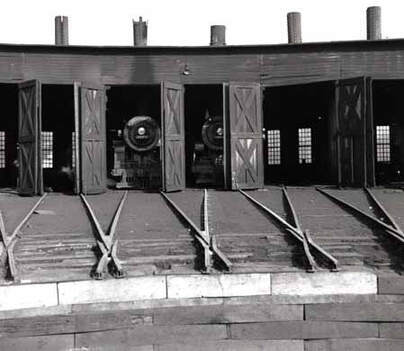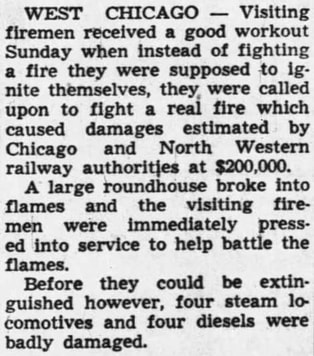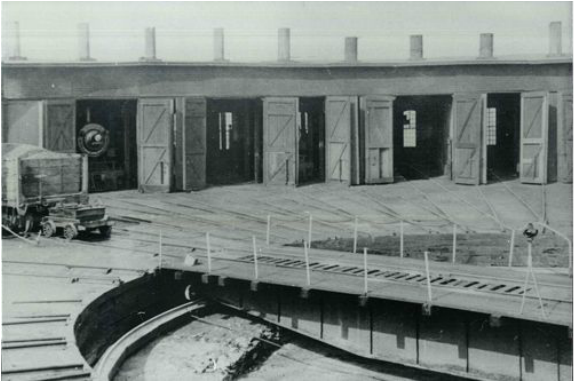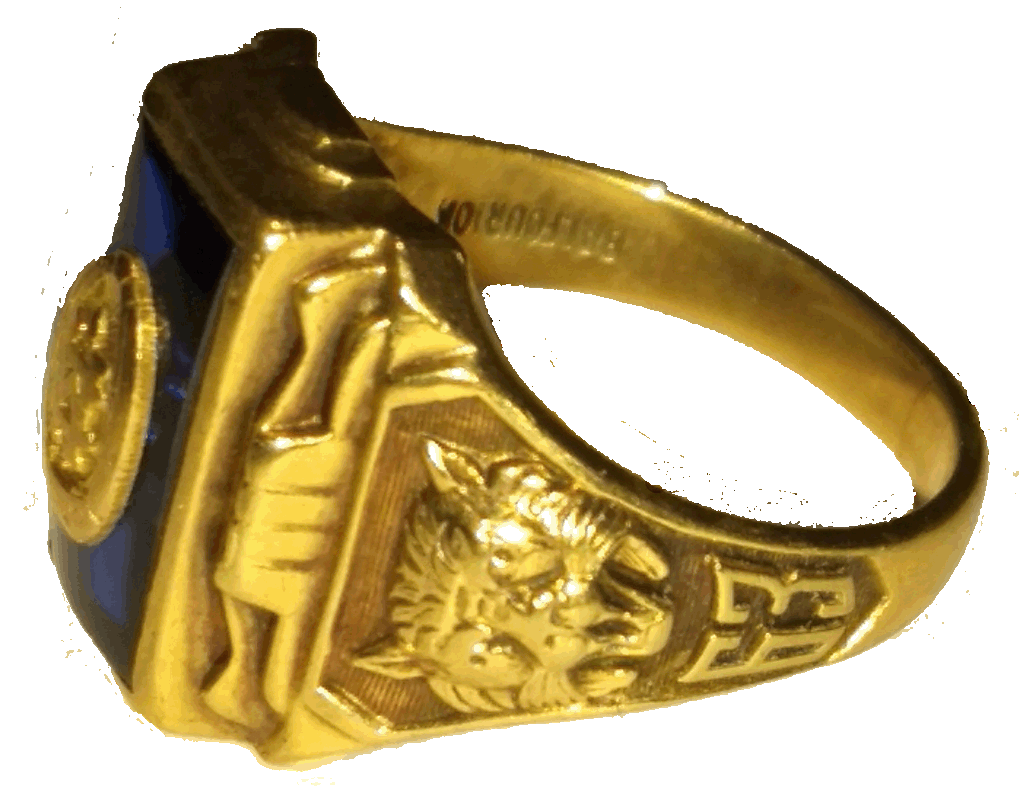Remembering The Chicago and North Western Railroad Roundhouse
 Photo courtesy of Larry Stark and the Bahr Family Yahoo Group.
Photo courtesy of Larry Stark and the Bahr Family Yahoo Group.
Do you recall seemingly eons ago the Chicago and North Western Railroad had a roundhouse on the east side of Wilson Street and on the south side of the tracks? The structure as we knew it was the second one built by the railroad, the first being built by the Galena and Chicago Union back in 1853.
The first roundhouse consisted of three stalls with a turntable and was built on the north side of Washington Street in back of what is now a Marathon gas station(1). Not far away were a machine shop, a rolling mill for repairing rail along with three water wells or tanks for filling the tender cars and three trackside wood sheds(2).
The second and final roundhouse was built in 1864 at the Wilson Street location and consisted of 16 stalls and a 60 foot turntable(3). The turntable was extended to 70 feet in 1913. By 1926 the stalls were extended to 75 feet to handle the larger engine/tender combinations. In 1947, two stalls were extended to 90 feet for still larger consists.
The first roundhouse consisted of three stalls with a turntable and was built on the north side of Washington Street in back of what is now a Marathon gas station(1). Not far away were a machine shop, a rolling mill for repairing rail along with three water wells or tanks for filling the tender cars and three trackside wood sheds(2).
The second and final roundhouse was built in 1864 at the Wilson Street location and consisted of 16 stalls and a 60 foot turntable(3). The turntable was extended to 70 feet in 1913. By 1926 the stalls were extended to 75 feet to handle the larger engine/tender combinations. In 1947, two stalls were extended to 90 feet for still larger consists.
 DeKalb Chronical May 20, 1953
DeKalb Chronical May 20, 1953
The Wilson Street roundhouse burned on May 17, 1953 damaging four steam locomotives and four diesel engines. The railroad estimated the loss at $200,000. A news paper clipping from the DeKalb Chronical summarizes what happened.
Donn Fairbank sent us an email with a link to an article in the Chicago Tribune written on the following day. The story tells of a scheduled burn with surrounding fire departments participating. As they arrived, they were immediately dispatched to work on the fire in progress. I think most people will enjoy the reading. Click on the link below and you will be transported back in time.
http://archives.chicagotribune.com/1953/05/18/page/1/article/300-visiting-firemen-go-to-blazes-in-west-chicago#text
Once you open the link and read the story you can scroll to the last page of the newspaper for a picture. In 1958, the remains of the roundhouse and turntable were removed.
Donn Fairbank sent us an email with a link to an article in the Chicago Tribune written on the following day. The story tells of a scheduled burn with surrounding fire departments participating. As they arrived, they were immediately dispatched to work on the fire in progress. I think most people will enjoy the reading. Click on the link below and you will be transported back in time.
http://archives.chicagotribune.com/1953/05/18/page/1/article/300-visiting-firemen-go-to-blazes-in-west-chicago#text
Once you open the link and read the story you can scroll to the last page of the newspaper for a picture. In 1958, the remains of the roundhouse and turntable were removed.
 Photo Courtesy of The Freinds of the West Chicago City Museum
Photo Courtesy of The Freinds of the West Chicago City Museum
I can recall the commuter coaches and steam engines parked for the night in the Washington Street location. The engine house and turntable were long gone from there, but the engines would have had a fire and the coal smoke would have been drifting out towards the street. The Wilson Street bridge was another place I wanted to be when a locomotive passed underneath as we were traveling across the bridge. There was something magical about the coal smoke that lingers with me today.
The same could not be said for the neighbors surrounding the roundhouse property. One account tells of painters working on a house and leaving for the day. Upon returning, the smoke had caused the paint to shrivel and needed to be removed and then repainted.
The roundhouses were the maintenance facilities for the steam locomotives and they employed numerous trades. Blacksmiths were the ones that kept the tires in good repair for the engine wheels. Forge welding, fitting and casting repairs would have been in their bag of tricks as well. Machinists would have done the pin and bearing work and turning of the tires and wheels prior to marrying the two together. Boiler makers handled the fire tubes, crown sheets, stay bolts and piping. Hostlers moved the engines in and out of the roundhouse and the general laborers handled the cleaning, of the engines and fireboxes.
Of the trades eliminated from the general workforce, the blacksmiths were among the first to leave. Boiler makers are still around today, just not nearly as many as before. Machinists held on to a long life, but the new machining centers have moved the machinists jobs over to the engineers who now write programs in 3D, download the data to the machine processor and tell the machine operator when to hit the GO button and when to change the part. One machinist can easily cover three to five machining centers.
General laborers are not in much demand either. The work rules, OSHA and EPA regulations have brought about a need for an educated individual capable of thinking. While there are those having a desire to do physical labor, they are hard to find. Even harder is finding one that is and has been drug free.
Please visit the links provided in this story if you are interested at all in the birth and growth of our childhood city. If you have information or a story to pass along, please do that as well.
The same could not be said for the neighbors surrounding the roundhouse property. One account tells of painters working on a house and leaving for the day. Upon returning, the smoke had caused the paint to shrivel and needed to be removed and then repainted.
The roundhouses were the maintenance facilities for the steam locomotives and they employed numerous trades. Blacksmiths were the ones that kept the tires in good repair for the engine wheels. Forge welding, fitting and casting repairs would have been in their bag of tricks as well. Machinists would have done the pin and bearing work and turning of the tires and wheels prior to marrying the two together. Boiler makers handled the fire tubes, crown sheets, stay bolts and piping. Hostlers moved the engines in and out of the roundhouse and the general laborers handled the cleaning, of the engines and fireboxes.
Of the trades eliminated from the general workforce, the blacksmiths were among the first to leave. Boiler makers are still around today, just not nearly as many as before. Machinists held on to a long life, but the new machining centers have moved the machinists jobs over to the engineers who now write programs in 3D, download the data to the machine processor and tell the machine operator when to hit the GO button and when to change the part. One machinist can easily cover three to five machining centers.
General laborers are not in much demand either. The work rules, OSHA and EPA regulations have brought about a need for an educated individual capable of thinking. While there are those having a desire to do physical labor, they are hard to find. Even harder is finding one that is and has been drug free.
Please visit the links provided in this story if you are interested at all in the birth and growth of our childhood city. If you have information or a story to pass along, please do that as well.
- Taken from Friends of the West Chicago City Museum website, eBook, Chapter 3. Scroll to the paragraph below the 1854 map of northern Illinois.
- Taken from Friends of the West Chicago City Museum website, eBook, Chapter 2.
- Locomotive Facilities, C&NW and CSt.Pm&O, Joseph A. Follmar, Chicago & North Western Historical Society.


